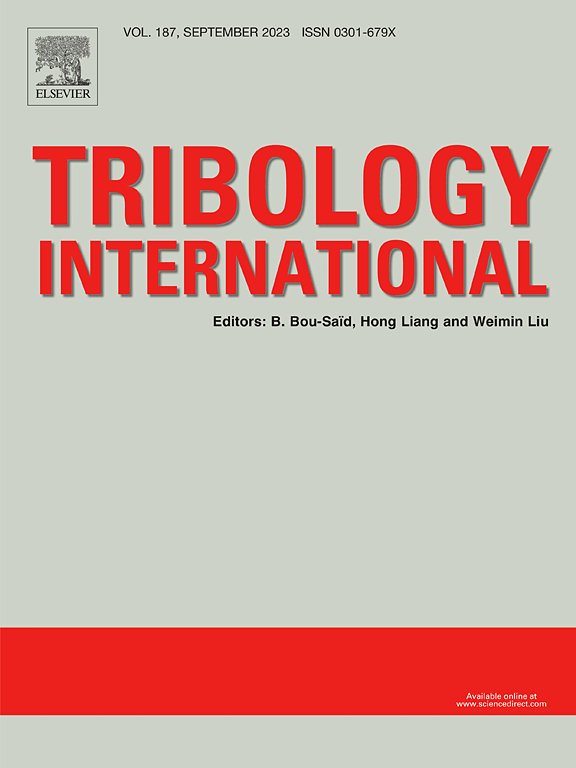基于表面增强拉曼光谱的摩擦学界面润滑油分子水平的原位观察
IF 6.1
1区 工程技术
Q1 ENGINEERING, MECHANICAL
引用次数: 0
摘要
本研究利用原位表面增强拉曼光谱(SERS)和本课课组开发的等离子体传感器直接监测滑动过程中润滑剂物种的分子结构。该方法具有对界面化学结构异常敏感和高时间分辨率(1 s)的特点,有助于跟踪润滑剂种类的变化。结果表明,作为润滑剂基础油的纯十二烷在滑动后立即降解,形成具有苯环的无定形碳。这种方法提供了高时间分辨率的碳降解的第一次观察。相反,对于含有月桂酸(铁界面表面活性添加剂)的润滑剂,月桂酸主要与铁底物配位,在滑动前以月桂酸铁的双齿配位,这种结构在滑动过程中持续存在。这表明羧酸离子(COO−)通过与铁底物保持配位而起到润滑膜的作用。此外,连续测量的SERS光谱显示出COO−对应区域的动态变化,表明羧酸离子之间的分子相互作用程度随时间而变化,COO−的双齿配位仍然占主导地位。这一发现有助于优化含有多种添加剂的润滑油混合物的配方。总之,这项研究提供了对滑动过程中化学结构的直接观察,而这在以前只是由于观察方面的挑战而推断出来的。这项工作有望大大提高对摩擦条件下各种基础油和添加剂的分子水平理解,促进更有效润滑油的分子设计和配方。本文章由计算机程序翻译,如有差异,请以英文原文为准。
In-situ molecular-level observation of lubricant species at tribological interface using surface-enhanced Raman spectroscopy
This study directly monitored molecular structures of lubricant species during sliding using in-situ surface-enhanced Raman spectroscopy (SERS) with plasmonic sensors developed by our research group. This method, characterized by exceptional sensitivity to interfacial chemical structures and high temporal resolution (1 s), facilitated tracking changes in lubricant species. Results for pure dodecane, used as the base oil for the lubricant, revealed immediate degradation upon sliding, forming amorphous carbon with benzene rings. This methodology provides the first observation of carbon degradation with high temporal resolution. In contrast, for the lubricant containing lauric acid, a surface-active additive at the iron interface, lauric acid primarily coordinated to the iron substrate, in bidentate coordination as iron laurate before sliding, with this structure persisting during sliding. This indicates that the carboxylate ions (COO−) function as a lubricating film by maintaining coordination with the iron substrate. In addition, continuously measured SERS spectra exhibited dynamic changes in the region corresponding to COO−, indicating that the degree of molecular interaction between carboxylate ions changes over time, with the bidentate coordination of COO− remaining predominant. This finding contributes to optimizing the formulation of lubricant blends with multiple additives. In conclusion, this study provided direct observation of chemical structures during sliding, which were previously only inferred owing to observational challenges. This work is expected to significantly enhance the molecular-level understanding of various base oils and additives under frictional conditions, facilitating the molecular design and formulation of more effective lubricants.
求助全文
通过发布文献求助,成功后即可免费获取论文全文。
去求助
来源期刊

Tribology International
工程技术-工程:机械
CiteScore
10.10
自引率
16.10%
发文量
627
审稿时长
35 days
期刊介绍:
Tribology is the science of rubbing surfaces and contributes to every facet of our everyday life, from live cell friction to engine lubrication and seismology. As such tribology is truly multidisciplinary and this extraordinary breadth of scientific interest is reflected in the scope of Tribology International.
Tribology International seeks to publish original research papers of the highest scientific quality to provide an archival resource for scientists from all backgrounds. Written contributions are invited reporting experimental and modelling studies both in established areas of tribology and emerging fields. Scientific topics include the physics or chemistry of tribo-surfaces, bio-tribology, surface engineering and materials, contact mechanics, nano-tribology, lubricants and hydrodynamic lubrication.
 求助内容:
求助内容: 应助结果提醒方式:
应助结果提醒方式:


